
Tulip: 7 beautiful companion planting ideas
Successful pairings, in the garden or in a pot!
Contents
Tulips are unrivalled flowers for bringing colour in spring. Their very numerous varieties, early or late, are declinate in an almost infinite palette of colour, allowing them to fit into any garden style. Tulips can be planted alone but are always better showcased when accompanied by other bulbs or by perennial plants.
Here are 7 ideas to combine tulips, in borders or in large containers. Get inspired!
Planting a naturalistic corner
Les botanical tulips trouvent facilement leur place dans un jardin naturaliste, où elles forment au fil des années de beaux tapetums en fleurs. Elles réapparaissent avec vigueur chaque année sans demander d’entretien et se plaisent dans les bordures et les rocailles, au pied d’arbres ou bushes à feuillage deciduous ou en masse dans une short grass meadow pour un effet encore plus naturel. Ces early tulips sont faciles à associer à d’autres bulbeuses à flowering printanière comme les hyacinths ou les muscari car elles se plantent au même moment.
La silhouette gracile des Muscari s’harmonise bien avec les tiges élancées des Tulips, avec lesquelles ils composent des scènes printanières fraîches empreintes de simplicité. Les Muscari blancs ‘White Magic’, ‘Mountain Lady’ ou ‘Pink Sunrise’ et leurs coloris tendres se marieront bien avec les flowers rose tendre des botanical tulip Tulipa clusiana ‘Lady Jane’, Tulipa greigii ‘Pour Elise’ ou Tulipa kaufmanniana ‘Johann Strauss’. Pour des associations plus contrastées, misez sur les coloris complémentaires ardents de la botanical Tulipa greigii ‘Petit Chaperon Rouge’ ou solaire de la Tulipa kaufmanniana ‘Goudstuck’ avec le bleu vif des Muscari aucheri ‘Blue Magic’.
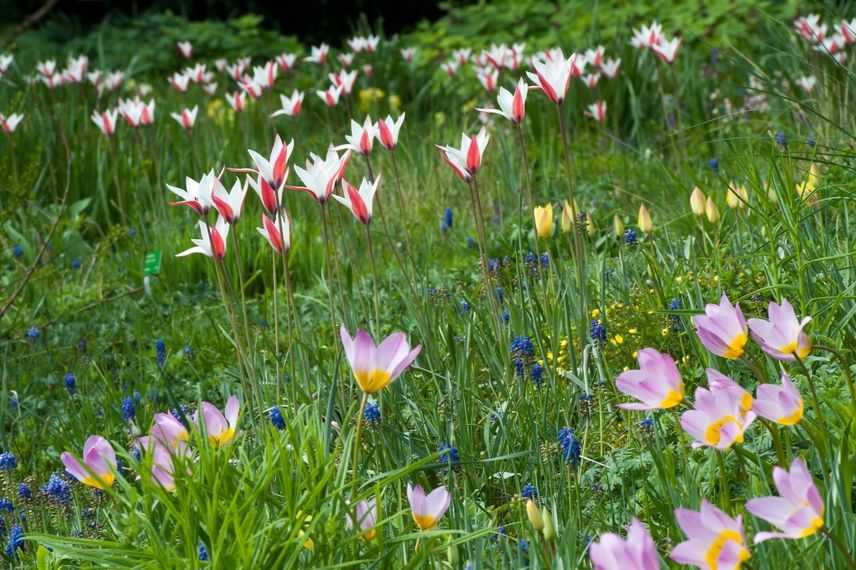
An example of natural association: Botanical tulips ‘Lilac Wonder’, ‘Lady Jane’ and Muscari
Pour créer des scènes colourées, raffinées ou délicates, mariez-les aux autres small spring bulbs comme les Crocus, Allium moly, Narcissi, Erythronium pagoda, Scilla sibirica, Fritillaria…
Plantez des bulbes de tulipes par touffes au milieu de petites perennials précoces telles que les Caucasian forget-me-nots, Cyclamen coum, primroses.
For chic, ultra-refreshing pairings
There’s a tulip for every desire! Single-flowered tulips can look dazzlingly pure in an elegant garden. For a simple, fresh display, pair Darwin-hybrid tulips such as ‘Ivory Floradale’, ‘Jaap Groot’ — deliciously crisp — with Fleur-de-Lys tulips (‘White Triumphator’, ‘Elegant Lady’), always prized for their long, tapered flowers with a sleek, contemporary look, summer snowflakes, ‘Iris Magnifica’, Allium stipitatum ‘White Giant’, and combine them with narcissi, jonquils and hyacinths.
Also consider viridiflora tulips with their flowers invariably striate or flamed with green, such as varieties ‘Virichic’ or ‘Spring Green’, which can be set among a few perennials such as alchemillas, primroses, Hellebore (x) sternii with chartreuse-green flowers, garrigue euphorbias with grey-green foliage and acid-green flowers (Euphorbia characias) to create pure, refreshing scenes.
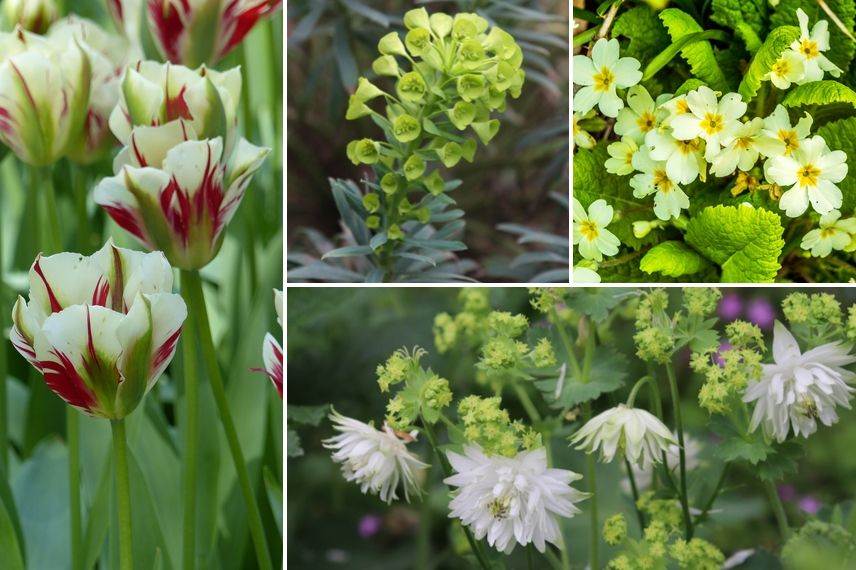
An example of an elegant pairing: Tulip ‘Flaming Spring Green’, Euphorbia characias ssp wulfenii, Primula vulgaris, Aquilegia ‘Green Apples’ and Alchemilla mollis
Discover other Tulips
View all →Available in 1 sizes
Available in 0 sizes
Available in 0 sizes
Available in 0 sizes
Available in 0 sizes
Available in 0 sizes
Available in 0 sizes
Available in 1 sizes
Available in 0 sizes
To add charm to an English-style mixed border
Some tulip varieties now bear double flowers, in some cases so full they evoke peonies or roses. With their varied colours, soft or vivid, and their opulent, naive blooms, this type of tulip brings whimsy and romance to English-style gardens, alongside the prettiest spring flowering. They are often perfect for bridging spring and summer flowering, favouring combinations in pastel shades such as white/pink or soft mauves.
Pair the very double flowers of tulips ‘Annelinde’, ‘Double Sugar’ or ‘Danceline’ with pastel varieties such as ‘Angélique’ and ‘Creme Up Star’. They benefit from being accompanied by a clump of Paeonia officinalis ‘Alba Plena’, Fritillaria persica, Eremurus which add verticality to the roundness of these tulips, and the small airy flowers of bleeding hearts, hardy geraniums, May Queen daisies, Tiarellas or forget-me-nots.
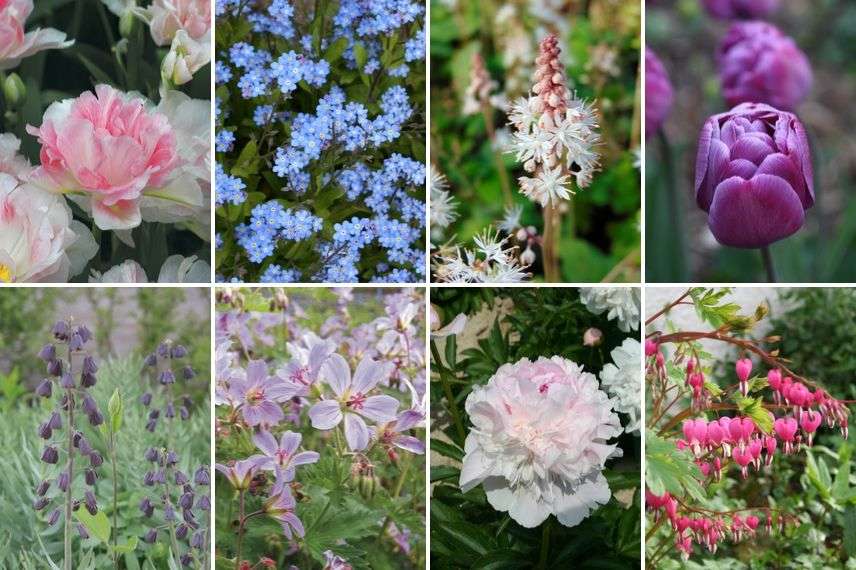
An example of an association in an English-style border: Tulip ‘Annelinde’, Forget-me-nots, Tiarella wherryi, Tulip ‘Blue Diamond’, Fritillaria persica, Geranium ‘Prelude’, Paeonia lactiflora ‘Alba Plena’ and Dicentra spectabilis
Read also
Tulips: planting, growing and careFor a baroque, eccentric scene
With their large, tousled, fringed, variegated and voluptuous flowers, parrot tulips are always striking in a warm-coloured border reserved for sunniest corners of garden.
The Tulip ‘Rasta Parrot’ brings together red, yellow, orange, pink, green and purple petals; you can pair it with Parrot Tulip ‘Black Parrot’, a very graphic, majestic tulip that offers black petals with red highlights to create striking contrasts. Both pair naturally with Fritillaria persica ‘Adiyaman’, a form with almost black flowers, and with Iris germanica ‘Devil Baby’ bearing very dark burgundy, almost black flowers. They make splendid combinations with Paeonia Itoh ‘Scarlet Heaven’ in scarlet red or with Euphorbia griffithii ‘Dixter’ in fiery tones. You can plant them alongside hardy geraniums, hostas or grasses such as Melica altissima ‘Atropurpurea’, all perennials that will help conceal yellowing leaves of tulips at end of their growing cycle.
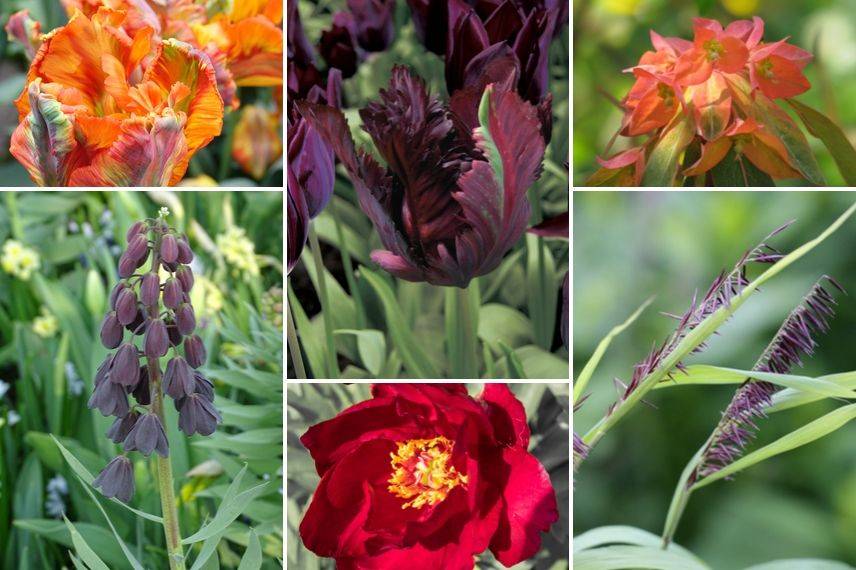
An example of a baroque arrangement: Tulip ‘Rasta Parrot’, Fritillaria persica ‘Adiyaman’, Tulip ‘Black Parrot’, Paeonia Itoh ‘Scarlet Heaven’, Euphorbia graffithii ‘Dixter’ and Melica altissima ‘Atropurpurea’
In a romantic, zesty style
Les dentate tulips are characterised by delicately fringed petals at the tips. Their flowering, lasting into May, is among the latest. They can be planted in borders, rockeries or flowerbeds where they combine with earlier tulips to extend the flowering period.
Focus is on their ultra-feminine shapes and the vividness of their often zesty, ‘girly’ colours, ranging from pure white and fresh pink to cherry red and magenta pink. Tulips ‘Cacharel’ ‘Barbados’ or ‘Match Point’ allow beautiful combinations with white tulips such as ‘Daytona’ or even black varieties like ‘Paul Scherer’, ‘Cuban Night’ that flower at the same time.
They pair perfectly with large perennials such as peonies, red bleeding hearts or Dicentra Burning Hearts®, hostas, and bushes such as hydrangeas and rhododendrons in matching flower tones.
So much pink would be suffocating without counterpoint of silver artemisias, mouse ears and glaucous grasses such as Festuca ‘Elijah Blue’. Plant at their feet small groundcover plants such as pink heucheras like ‘Berry Smoothie’ and ‘Georgia Plum’, hardy geraniums, Hesperis matronalis or dame’s rocket which will conceal any unsightly foliage after flowering.
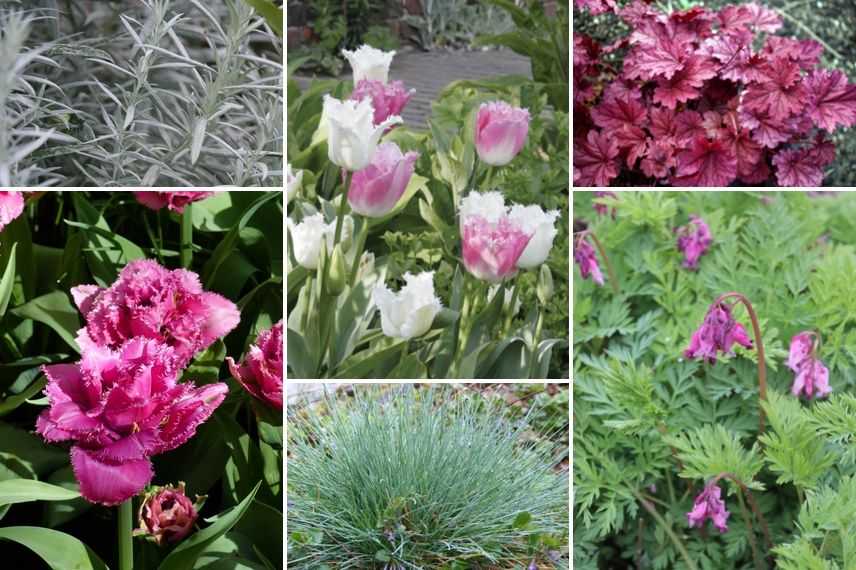
An example of a romantic pairing: Artemisia ‘Silver Queen’, Tulip ‘Match Point’, Tulips ‘Huis Ten Bosch’ and ‘Daytona’, Festuca glauca, Heuchera ‘Berry Smoothie’ and Dicentra formosa ‘Luxuriant’
Rockery
Create a spring apotheosis in a sunny rockery! Turn to smaller varieties, such as botanical tulips humilis (‘Lilliput’, ‘Violacea Yellow Base’) and the botanical tulip polychroma, true little gems not exceeding 10 cm. Pair these small tulips with Muscari, Ipheion uniflorum, Erythronium pagoda, anemone blanda, other botanical tulips or hyacinths to extend flowering of your rockery. Add small mat-forming groundcover plants, such as sedums, aubrietas, houseleeks and a few grasses Festuca, Stipa or Carex.
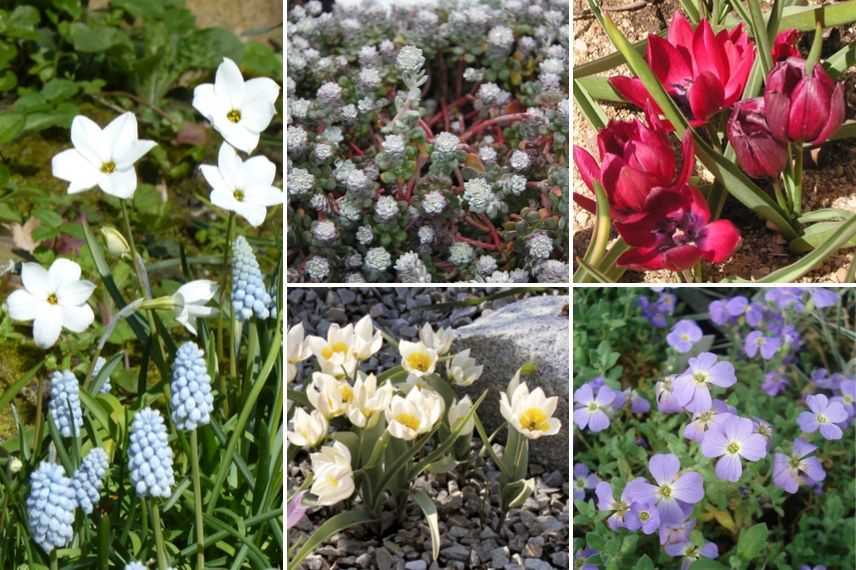
An example of a rockery combination: Ipheion and Muscari, Sedum ‘Cape Blanco’ (yellow-flowering and takes over from tulips in May–June), Tulip ‘Lilliput’, Tulip polychroma and Aubrieta ‘Cascade Blue’
In a beautiful spring planter
Tulips Tulips lend themselves to every desire to brighten your terrace or balcony and bring freshness and brightness in spring. Opt for the smaller varieties. Create a stunning composition in deep purple / midnight-blue tones, for example by planting the Tulip ‘Queen of Night’ or the Tulipa humilis pulchella Violacea ‘Black Base’ with muscaris ‘Plumosum’ and M. negletum, Fritillaria meleagris and pansies.
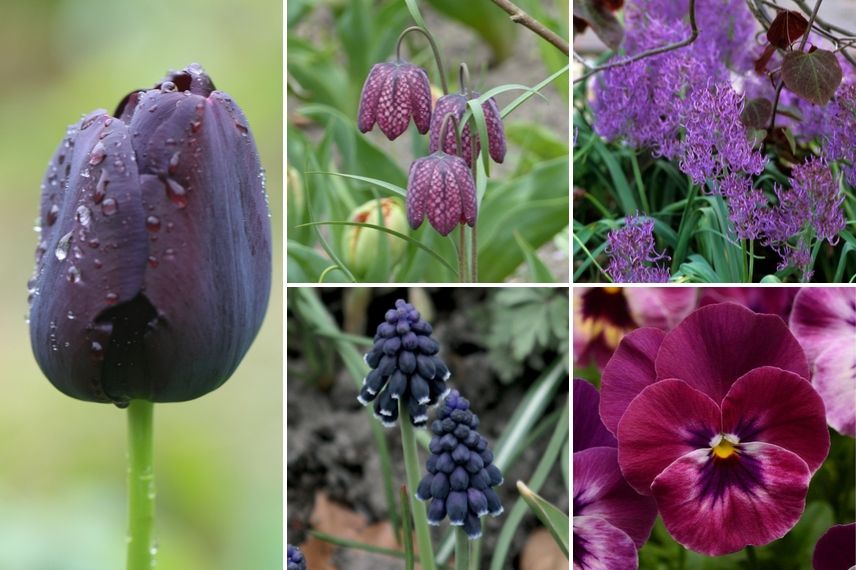
Example of a potted arrangement: Tulip ‘Queen of Night’, Fritillaria meleagris, Muscari comosum ‘Plumosum’, Muscari neglectum and Viola ‘Cool Wave Raspberry’
For a fresh, luminous composition, pair Triumph tulips ‘White Dream’ with small Narcissus ‘Paperwhite’ and ‘Tête-à-Tête’, or Triandrus narcissus ‘Thalia’, mini daffodils, muscari and white hyacinths, and Crocus Mammouth ‘Jeanne d’Arc’.
You can plant the bulbs together in the same pot but at different depths, lasagne-style.
- Subscribe!
- Contents
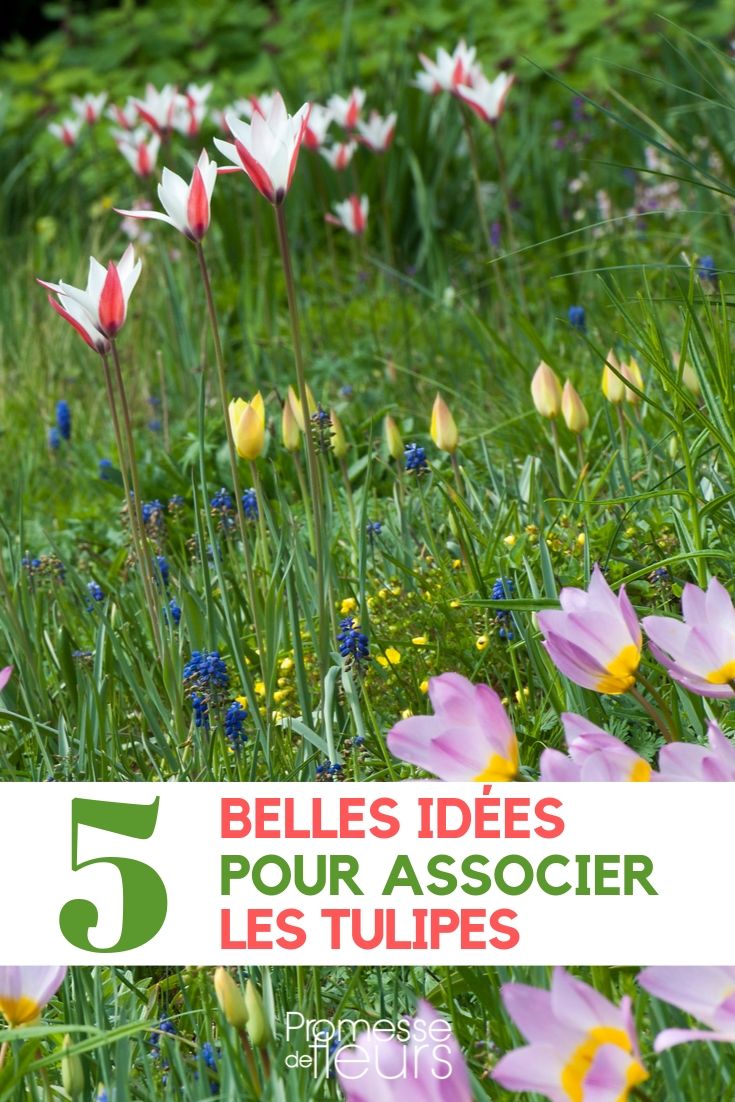































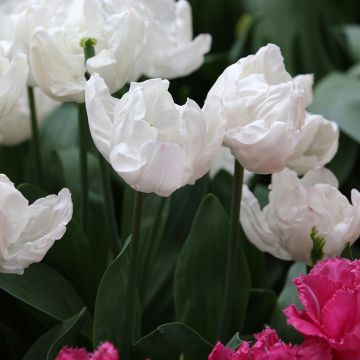

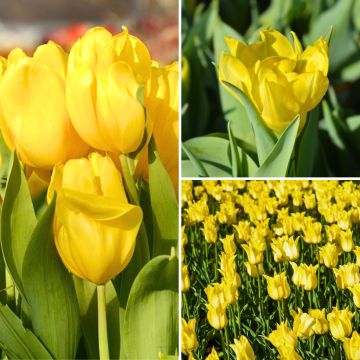
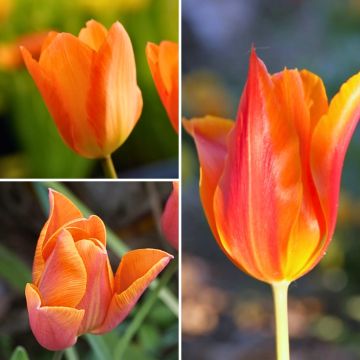
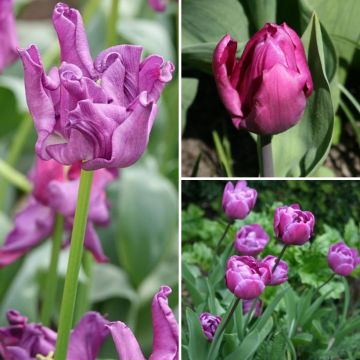

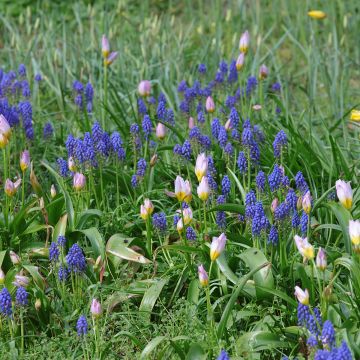
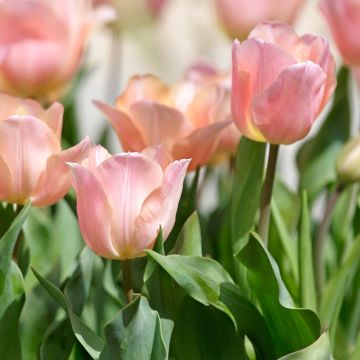
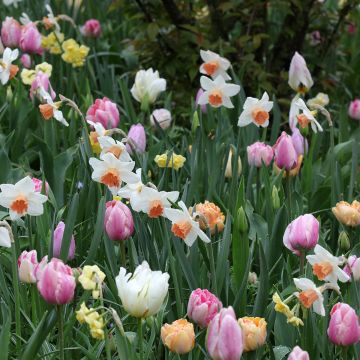
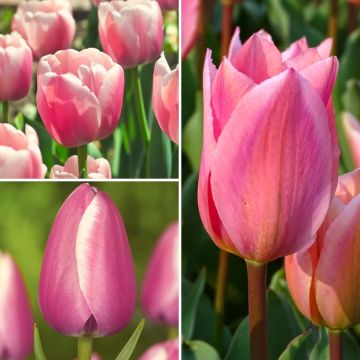
Comments